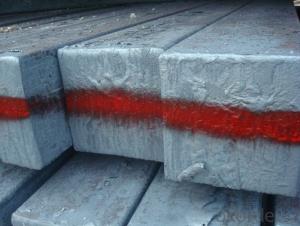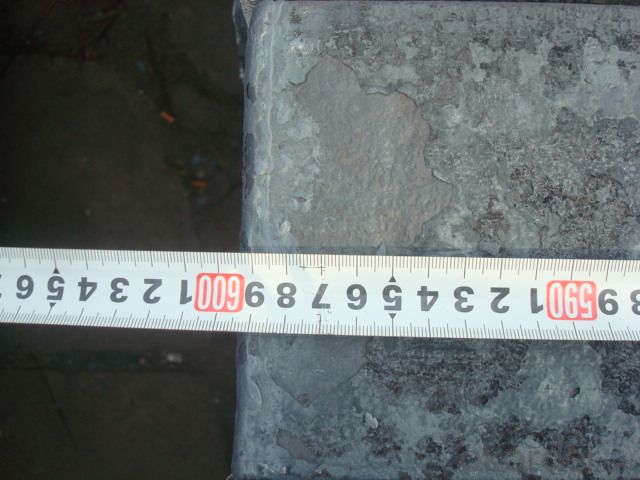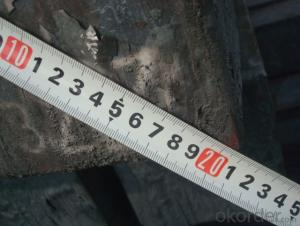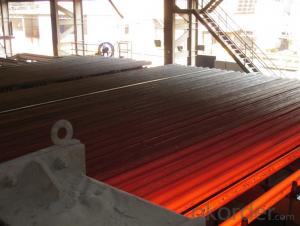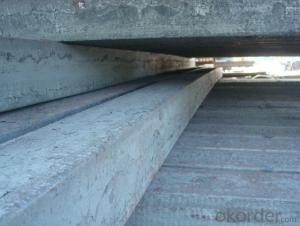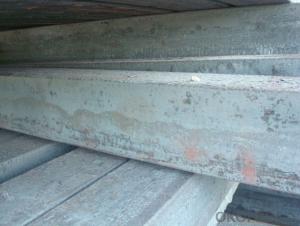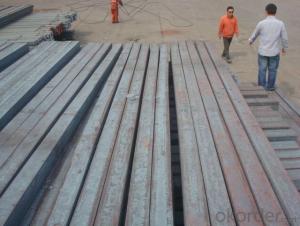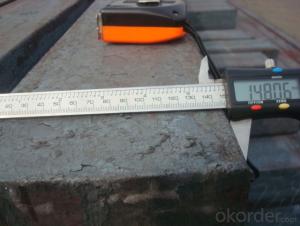Alloyed Steel Billet/Bloom Manufactured by Continue Casting Blast Furnace
- Loading Port:
- Tianjin
- Payment Terms:
- TT OR LC
- Min Order Qty:
- 1000 m.t.
- Supply Capability:
- 10000 m.t./month
OKorder Service Pledge
OKorder Financial Service
You Might Also Like
Alloyed Steel Billet/Bloom Manufactured by Continue Casting Blast Furnace
1.Structure of Alloyed Steel Billet/Bloom Manufactured by Continue Casting Blast Furnace
Continue Casting Steel Billet Manufactured By Blasting Furnace is the raw material of all kinds of steel mill. Billet section of square, round, flat, rectangular and abnormity, etc Several, mainly related to shape of rolled products. Simple rolled section steel, choose cross section of square billet or rectangular billet. rolling The sector products such as flat steel, Angle steel, select the rectangular billet or slab. Had better profiled billet when production beams, channels, and in rolling process Lines and improve the yield. The raw material of round billet is the production of seamless tube.
2.Main Features of Alloyed Steel Billet/Bloom Manufactured by Continue Casting Blast Furnace
Continue Casting Steel Billet Manufactured By Blasting Furnace section size should meet the requirements of rolling deformation and finished product quality, but also roll strength and biting condition of restrictions. General steel Billet section height H. And the roll diameter D The ratio of the ( namely H/D) Should be less than or equal to zero 0.5 . Length of steel billet by finishing temperature, Rolling time and the length of the product Or times ruler. When heated too long accident prone to bump the furnace wall of steel, too short, furnace bottom utilization rate is not high, influence the heating furnace production. For the production Choose a variety of steel and steel billet, should consider the affinities of billet, as far as possible in order to improve the productivity of the roughing mill, simplify the stock management of workshop.
There are three shapes of the steel billets: square billet, slab, rectangular billet The Chinese billet, rectangular billet is mainly suitable for rolling hot rolled strip, building reinforced bar, Ordinary wire, high speed wire rod and various small profile. Of the slab are mainly used for rolling plate and hot coil sheet.
3. Alloyed Steel Billet/Bloom Manufactured by Continue Casting Blast Furnace Images
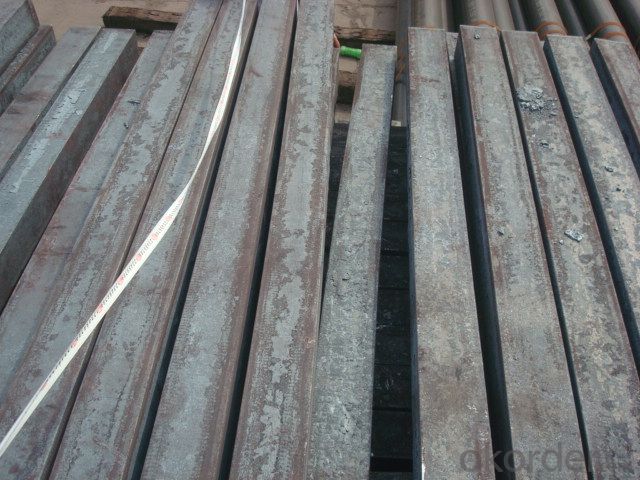

4. Alloyed Steel Billet/Bloom Manufactured by Continue Casting Blast Furnace Specification
Continue Casting Steel Billet Manufactured By Blasting Furnace rolled steel, after processing can be used for mechanical parts, forging parts, processing all kinds of steel, steel Q345B channel steel, wire rod is the role of the billet. Steel billet is used in the production of semi-finished products, generally cannot be used directly for the society. Steel billets and steel are strictly divided into standard, cannot decide to whether the business enterprise of the final product, and according to unified standards to perform the whole society. Typically, billet and the steel is relatively easy to distinguish, but for some steel billet, and have the same specification and same steel purposes (such as rolling tube billet), whether can be used for other industries, whether through steel processing process, whether through a finished product rolling mill processing to distinguish
Material standard The editor Range of thickness: 150-240 - mm + / - 5 mm width range: 880-1530 - mm + / - 20 mm Length: 3700-10000 - mm + / - 500 - mm Cross-sectional size: 64 * 64; 82 * 82; 98 * 98; 124 * 124; 120 * 150; 152 * 164; 152 * 170 mm Length: 9000 mm Section of tolerance: billet: 1.0 + / - 2.0-1.0 + / - 1.0 mm slab: width: + / - 2.0 mm thickness: + / - 3.0 mm The length tolerance: + / - 200 mm Section diagonal tolerance: 3.5-8.0 MM Billet section size protrusions requirements: < 1242 mm, do not allow; > = 1242 mm, < = 2 mm 1242 mm, < = 3 mm Beheading (shear) extension deformation: < 1242 mm billet: no control; The slab: < = 15 mm Surface tilt: no more than billet section 0.1 Bending: every 1 m length is not more than 10 mm The distortion: length < = 5 m, < = 11. ; The length of the < = 7.5 M, < = 5. Material % 3 sp/PS chemical composition: C Mn Si S P
If the chemical composition not meet the range requirement, maybe have some problem for example:
Big wait for a phenomenon, the finished slab surface convex hull, cross section on the tongue shape wave, serious billet through a long hole. (2)Internal crack.The internal crack of steel,Has a bulging belly phenomenon of rolling shear255 garlgSteel cutting surface form a symmetricalThere are cracks under the single or double wave crest and wave and emit blue fire phenomenon, wave no precipitate low melting point material.
Or the heart temperature is higher than the surface temperature of ingot, the rolling bulging belly.The rolling surface of the convex of steel,When shear sag, spread, shear section on"П"Glyph crest, no low melting point material overflow the crest.
5.FAQ of Alloyed Steel Billet/Bloom Manufactured by Continue Casting Blast Furnace
We have organized several common questions for our clients,may help you sincerely:
①What kinds of the raw material of the steel billet producing?
Iron ore,coke and other chemical composition material.
②How to make the freight cost lower?
If your quantity is over 30,000tons once, the cost is lowest.
③How to make the delivery term shorter?
It is better you can purchase the normal size or you can tell us your plan in advanced.
- Q: What are the potential applications of steel billets in the medical industry?
- Steel billets have a wide range of potential applications in the medical industry. One potential application is in the manufacturing of surgical instruments. Steel billets can be shaped and machined into various surgical tools such as scalpels, forceps, and scissors. The high strength and durability of steel make it an ideal material for these instruments, ensuring their longevity and reliability in surgical procedures. Another potential application of steel billets in the medical industry is in the production of medical implants. Steel billets can be processed and formed into implants like joint replacements, spinal implants, and dental implants. The biocompatibility of steel, combined with its strength and resistance to corrosion, makes it a suitable material for implants that need to withstand the body's environment and provide long-term support. Moreover, steel billets can be utilized in the construction of medical equipment and machinery. Steel is commonly used in the manufacturing of medical beds, surgical tables, and imaging devices like MRI machines and X-ray equipment. The structural integrity and stability of steel make it an excellent choice for these applications, ensuring the safety and functionality of medical equipment. Additionally, steel billets can be employed in the production of medical furniture and storage units. Steel cabinets and shelves are commonly used in medical facilities to store equipment, supplies, and medications. The strength and durability of steel ensure that these storage solutions can withstand the rigorous demands of the healthcare environment. In summary, the potential applications of steel billets in the medical industry are vast and diverse. From surgical instruments and medical implants to equipment and furniture, steel's properties make it a valuable material for enhancing the quality and effectiveness of healthcare products and facilities.
- Q: What are the different types of steel billet surface treatments?
- There are several different types of steel billet surface treatments, including pickling, shot blasting, and painting. Pickling involves removing impurities and oxides from the surface of the billet using an acid solution. Shot blasting is a process in which small metallic or abrasive particles are blasted onto the surface of the billet to remove rust, scale, and other contaminants. Painting involves applying a protective coating or layer of paint to the surface of the billet to prevent corrosion and improve its appearance.
- Q: How are steel billets used in the manufacturing of structural steel?
- Steel billets are a crucial raw material in the manufacturing of structural steel. They are heated, shaped, and then cooled to form various steel products such as beams, columns, and plates. These billets serve as the starting point for the production process, where they are further processed and transformed into different shapes and sizes to meet the specific requirements of construction projects.
- Q: How are steel billets used in the production of industrial boilers?
- Steel billets are used in the production of industrial boilers as they serve as the primary raw material for manufacturing boiler components such as tubes, pipes, and plates. These billets are heated, forged, and shaped into various boiler parts, ensuring the strength, durability, and reliability required for efficient boiler operation in industrial settings.
- Q: What are the main factors affecting the corrosion resistance of stainless steel billets?
- The main factors affecting the corrosion resistance of stainless steel billets are the composition of the alloy, the presence of impurities, the manufacturing process, and the environment in which the billets are exposed. The composition of the stainless steel alloy plays a crucial role in determining its corrosion resistance. The addition of elements such as chromium, nickel, and molybdenum enhances the resistance to corrosion. These alloying elements form a protective oxide layer on the surface of the stainless steel, which acts as a barrier against corrosive agents. Impurities present in the stainless steel billets can also affect their corrosion resistance. For example, the presence of sulfur can lead to the formation of sulfide inclusions, which can decrease the overall corrosion resistance of the material. Therefore, the control of impurities during the manufacturing process is essential to ensure optimal corrosion resistance. The manufacturing process used to produce stainless steel billets can also impact their corrosion resistance. Factors such as temperature, cooling rate, and the presence of contaminants during the production process can affect the microstructure of the material, which in turn influences its corrosion resistance. Lastly, the environment in which the stainless steel billets are exposed plays a significant role in their corrosion resistance. Factors such as temperature, humidity, pH level, and the presence of corrosive agents such as acids or chlorides can accelerate the corrosion process. Therefore, it is essential to consider the specific environmental conditions when selecting stainless steel billets for a particular application. In conclusion, the corrosion resistance of stainless steel billets is influenced by the alloy composition, the presence of impurities, the manufacturing process, and the environment in which they are exposed. By carefully considering these factors, it is possible to select stainless steel billets with optimal corrosion resistance for a wide range of applications.
- Q: How do steel billets differ from steel bars?
- Steel billets and steel bars are both forms of semi-finished steel products, but they differ in terms of their size, shape, and production process. Steel billets are typically square or rectangular in shape and have a larger cross-sectional area compared to steel bars. They are produced through a casting process, where liquid steel is poured into molds and then allowed to solidify. On the other hand, steel bars are long, cylindrical shapes that are formed by rolling billets through a series of rolling mills. The rolling process increases the length and reduces the cross-sectional area of the steel, resulting in a more uniform shape and size.
- Q: What are the different types of defects in steel billets?
- There are several types of defects that can occur in steel billets, including surface defects such as cracks, scabs, and laps, as well as internal defects like inclusions, segregation, and shrinkage cavities. These defects can affect the quality and performance of the steel and may require remedial measures or rejection of the billets.
- Q: How are steel billets used in the manufacturing of electrical appliances?
- Steel billets are used in the manufacturing of electrical appliances as a primary raw material for various components, such as casings, frames, and supports. These billets are first heated and then shaped through processes like rolling or extrusion to create the desired parts. The strength, durability, and conductivity of steel make it an ideal material choice for ensuring the structural integrity and efficient functioning of electrical appliances.
- Q: Are steel billets prone to cracking during production?
- Yes, steel billets are prone to cracking during production. Due to the high temperatures and rapid cooling involved in the production process, internal stresses can develop in the billets, leading to cracks. Proper handling, heat treatment, and quality control measures can help minimize the risk of cracking.
- Q: How do steel billets contribute to the automotive industry?
- Steel billets play a crucial role in the automotive industry as they are the raw materials used to manufacture various components such as engine blocks, transmission gears, axles, and chassis. These billets are forged and shaped into specific parts, providing the required strength, durability, and performance characteristics needed for automobiles. Additionally, steel billets offer excellent resistance to corrosion and high temperatures, ensuring the safety and reliability of vehicles on the road.
Send your message to us
Alloyed Steel Billet/Bloom Manufactured by Continue Casting Blast Furnace
- Loading Port:
- Tianjin
- Payment Terms:
- TT OR LC
- Min Order Qty:
- 1000 m.t.
- Supply Capability:
- 10000 m.t./month
OKorder Service Pledge
OKorder Financial Service
Similar products
Hot products
Hot Searches
Related keywords
